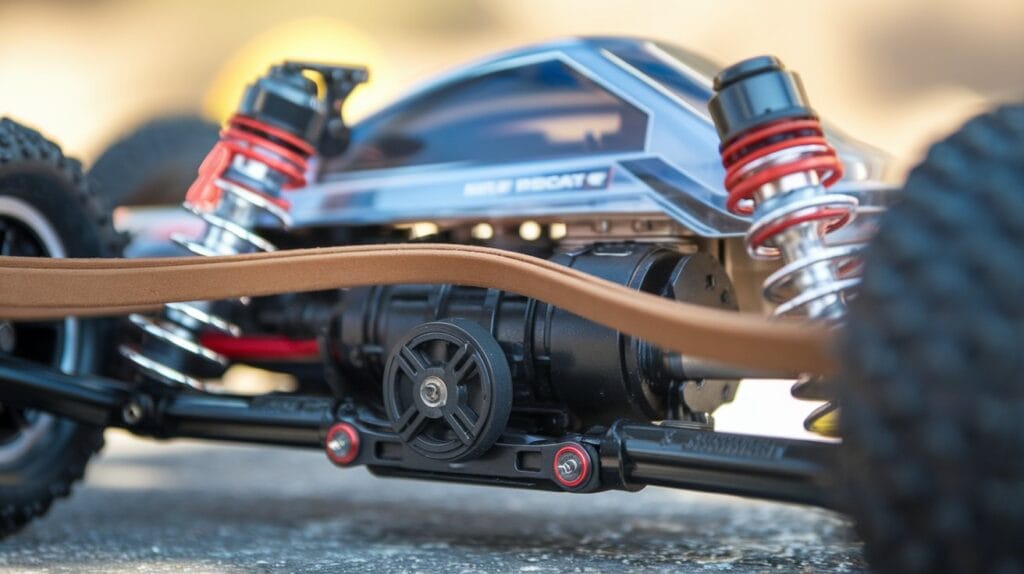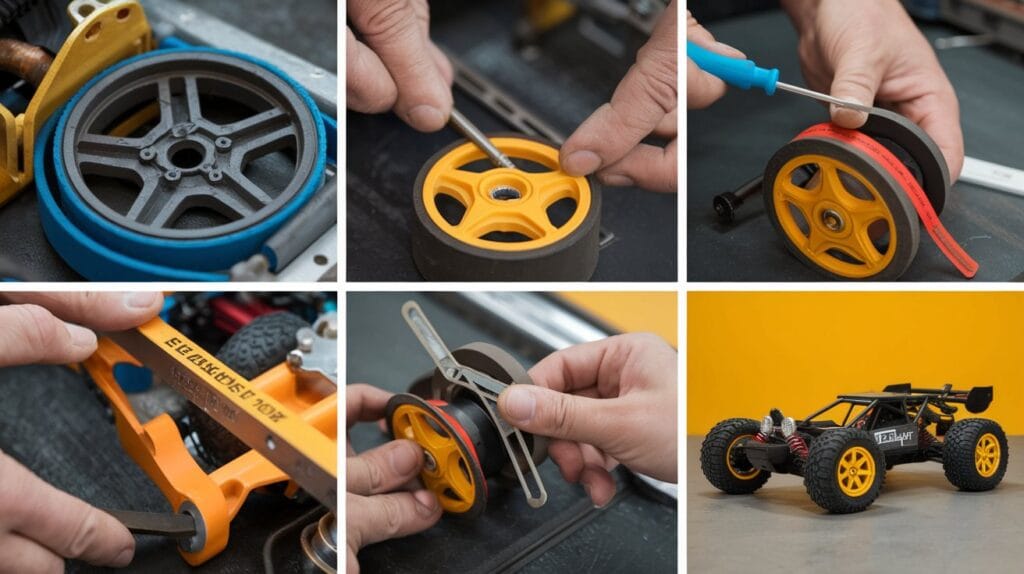If you’re passionate about Redcat RC cars, you know that maintaining and adjusting your vehicle is crucial to maximizing performance. One key area of focus is the belt-driven system, which demands proper tension for smooth operation. In this guide, we’ll explore how to adjust a belt-driven Redcat RC car effectively, why this matters, and provide step-by-step instructions to ensure your RC car runs at its best.
To adjust your Redcat RC car’s belt, first loosen the tensioner screws, then gently adjust the belt until it has slight, even tension. This simple process prevents slippage, reduces wear, and ensures smooth power transmission for optimal performance on any terrain.
Why Belt Adjustment is Essential for Redcat RC Cars

The belt in a Redcat belt-driven RC car transfers power from the motor to the wheels. Proper tension is key; if the belt is too loose, it slips, causing power loss and potential engine damage. Conversely, an overly tight belt can strain the motor and other components, leading to premature wear. Adjusting the belt on your Redcat RC car may seem complex at first, but it’s an essential skill that helps prevent costly repairs and improves your car’s performance.
Tools You’ll Need for Belt Adjustment
Before adjusting the belt, make sure you have these tools ready:
- Hex drivers – essential for loosening and tightening screws.
- Screwdriver set – with varied tips to fit all types of screws.
- Pliers – helpful for handling small parts.
- Belt tension gauge (optional) – provides precision in measuring belt tension.
- Allen wrenches – for adjusting specific components.
- Lubricant (silicone-based) – keeps the belt and pulleys in optimal condition.
Optional tools like a caliper and thread lock can further ensure precise adjustments and prevent screws from loosening over time.
Also Read: How Long Does a Car Wrap Last? Uncover the Surprising Truth
Recognizing Signs That Your Belt Needs Adjustment
How do you know it’s time to adjust the belt? Here are common signs:
- Noisy Operation: Squealing or grinding sounds indicate loose or misaligned belts.
- Sluggish Response: If your RC car hesitates when accelerating, the belt might be too tight, adding resistance.
- Belt Slippage: A belt that regularly slips off its pulley is too loose and needs immediate tightening.
- Visible Wear: Cracks, fraying, or other wear and tear signs on the belt signal that it needs attention or replacement.
Each of these symptoms can impact your RC car’s performance, so keep an eye out and take action when needed.
Step-by-Step Belt Adjustment Guide for Redcat RC Cars

Follow these steps to adjust your Redcat RC car’s belt accurately. Proper adjustments prevent unnecessary wear and ensure peak performance.
Step 1: Initial Inspection of Belt and Pulleys
Begin by inspecting the belt and pulleys:
- Check for Visible Damage: Look for frays, cracks, or worn-out sections on the belt. If damaged, consider replacing the belt rather than adjusting it.
- Examine the Pulleys and Gears: Inspect for cracks, worn teeth, or metal shavings. Misaligned or worn pulleys can cause uneven wear on the belt.
If everything appears intact, proceed with the adjustment.
Step 2: Loosen the Belt Tensioner
The belt tensioner is typically located near the motor mount. To loosen it:
- Locate the Tensioner Screws: Using a hex driver or screwdriver, loosen the tensioner screws slightly to relieve pressure on the belt.
- Avoid Over-loosening: Keep the belt in place by not fully loosening the screws; it should maintain minimal tension to prevent it from slipping off.
Step 3: Adjust Belt Tension
Once the belt is loose, adjust it to the proper tension:
- Apply Light Pressure: Press down lightly on the belt to test its slack. Ideally, the belt should have about 1-2mm of play, ensuring it’s not too loose to slip but not overly tight to create friction.
- Shift the Motor (if needed): On some models, you may need to slightly shift the motor to adjust the belt’s tension. Do this gently to avoid damaging the belt or other components.
- Use a Tension Gauge (Optional): For added precision, use a belt tension gauge to confirm you’ve achieved the ideal tightness.
Step 4: Align the Belt and Pulleys
Proper alignment ensures smooth operation and minimizes wear:
- Check Belt Alignment: Ensure the belt runs straight along the pulleys, with no noticeable tilt or misalignment.
- Use a Straight Edge: Align the pulleys with a straight edge if available, ensuring both pulleys are in line and the belt moves smoothly across them.
- Re-adjust if Necessary: Misaligned belts can quickly wear out, so take the time to adjust until the belt and pulleys are perfectly aligned.
Step 5: Tighten and Test
With the belt tension and alignment set, it’s time to secure everything in place:
- Tighten the Tensioner Screws: Ensure the screws are secure but avoid over-tightening to prevent undue strain.
- Manual Test: Rotate the wheels manually to see if the belt moves freely without slipping or creating resistance.
- Test Run: Take your Redcat RC car for a test drive. Listen for any unusual noises and check for smooth acceleration.
Advanced Tips for Fine-Tuning Belt Tension
For advanced users, fine-tuning belt tension can further enhance performance, especially for modified (mod) and stock RC cars.
Mod vs. Stock Belt Tension Settings
- Modified Cars: Generally, tighter belts are recommended to prevent slippage at high speeds. A tighter belt provides stability, especially for high-powered RC models.
- Stock Cars: A looser belt setting can improve efficiency and reduce drag, making the car easier to handle on straightaways and turns.
Balancing Front and Rear Belt Tension
Adjusting front and rear belt tension individually helps achieve specific driving characteristics:
- Tighter Front Belt: Adds forward drive, enhancing corner exit speed by allowing the car to pull smoothly out of turns.
- Looser Rear Belt: Adds rear-end stability and makes handling more predictable, especially in technical sections.
Common Mistakes to Avoid in Belt Adjustment
Avoid these common errors to keep your Redcat RC car performing well:
- Over-Tightening: Excessive tension strains the motor and gears, causing faster wear.
- Under-Tightening: A belt that’s too loose will slip, compromising power transmission.
- Ignoring Alignment: Misalignment shortens belt life and creates unnecessary friction, impacting performance.
Also Read: How Do You Remove Scratches from Car Dashboard
Maintenance and Troubleshooting Tips
Regular maintenance keeps your belt-driven Redcat RC car in peak condition. Here’s how to maintain and troubleshoot common issues:
Routine Belt Checks and Maintenance
- Inspect Tension Regularly: Check belt tension every few runs, particularly after high-speed sessions or rough terrain.
- Clean the Belt and Pulleys: Dust and debris can accumulate, causing slippage and wear. Use a soft brush or cloth to clean these areas regularly.
Lubrication Tips for Optimal Performance
- Use Silicone-Based Lubricants: For belts and pulleys, silicone-based lubricants work best. Avoid petroleum-based products, which can degrade rubber components.
- Apply Lightly: A small amount is enough to reduce friction and keep components smooth without attracting dust.
Storage Tips
When not in use, proper storage helps extend the lifespan of your RC car:
- Remove the Battery: Prevents potential battery leaks.
- Store in a Cool, Dry Place: Keeps rubber belts from warping or drying out.
- Use a Stand: Prevents flat spots on tires, ensuring your car is ready for action anytime.
Troubleshooting Common Issues
- Belt Slippage: Re-check tension, alignment, and clean the pulleys.
- Noise Issues: Noise often indicates a loose belt, misalignment, or lack of lubrication.
- Unusual Wear: Inspect for damage and replace worn belts or pulleys promptly.
Also Read: Car Window Tinting Costs in 2024: What You Need to Know!
Conclusion
Adjusting the belt on your Redcat RC car might seem intimidating at first, but it’s a straightforward process once you get the hang of it. Regular belt adjustments and maintenance will keep your car running smoothly, allowing you to enjoy enhanced performance and durability. Remember, a well-maintained Redcat RC is more responsive, reliable, and ready to perform at its peak—so grab your tools and give your RC car the care it deserves!
FAQs
You should check and adjust the belt tension every few runs, especially after high-speed or rough terrain driving. Regular inspections help ensure optimal performance and prevent premature wear.
Yes, you can adjust the belt without a gauge by pressing the belt lightly with your finger. Aim for a small amount of give, about 1-2mm, to ensure it’s not too loose or overly tight.
If the belt keeps slipping, check for proper alignment and ensure there’s no debris on the pulleys. If slippage continues, the belt may be worn and require replacement.
A belt that’s too tight may make squeaking noises, feel rigid when pressed, or cause sluggish car performance. Excessive tightness can also strain the motor and lead to quicker wear on components.